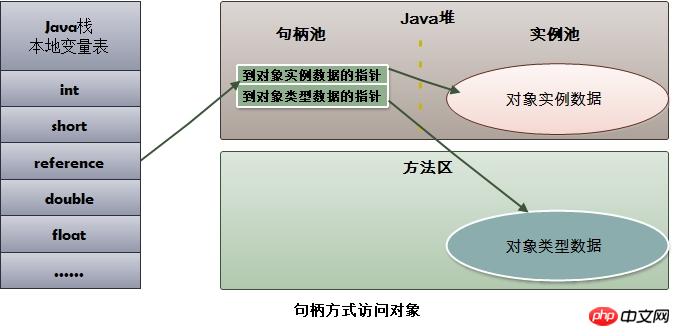Detailed introduction to object access in Java virtual machine (picture)
This article mainly introduces the relevant information about the detailed explanation of object access in the java virtual machine. Friends in need can refer to the following
Detailed explanation of object access in the java virtual machine
Object access will involve three memory areas: Java stack, Java heap, and method area.
Such as the following code:
Object objectRef = new Object();
Assuming this code appears in the method body, the "Object objectRef" part will be reflected in the local variables of the Java stack, as A reference type data appears. The "new Object()" part will be reflected in the Java heap, forming a structured memory that stores all instance data values of the Object class type, based on the specific type and the object memory layout implemented by the virtual machine. Differently, the length of this memory is not fixed. In addition, the java heap must also include address information that can find this object type data (such as object type, parent class, implemented interface, methods, etc.). These data types are stored in the method area.
The reference type in the Java virtual machine specification only stipulates a reference address pointing to the object, and does not define the method through which this reference should be located to access the object location in the Java heap. Therefore Different virtual machine implementations may have different access methods. There are two mainstream methods: using handles and direct pointers.
#: Java pile will be divided into a piece of memory as the handle pool. Reference is stored in the handle address of the object, and the handle contains the object instance data and type data's respective specific address information.

Pointer access method: The reference variable directly stores the address of the object, and part of the java heap object stores the object instance data, and the other part stores Object type data.

These two methods of accessing objects have their own advantages. The biggest advantage of using the handle access method is that the stable handle address is stored in the reference and only needs to be changed when the object is moved. The instance data pointer in the handle, and the reference does not need to be changed. The biggest advantage of using the pointer access method is that it is fast. It saves the time overhead of pointer positioning. As far as the virtual machine is concerned, it uses the second method (direct pointer access).
The above is the detailed content of Detailed introduction to object access in Java virtual machine (picture). For more information, please follow other related articles on the PHP Chinese website!

Hot AI Tools

Undresser.AI Undress
AI-powered app for creating realistic nude photos

AI Clothes Remover
Online AI tool for removing clothes from photos.

Undress AI Tool
Undress images for free

Clothoff.io
AI clothes remover

AI Hentai Generator
Generate AI Hentai for free.

Hot Article

Hot Tools

Notepad++7.3.1
Easy-to-use and free code editor

SublimeText3 Chinese version
Chinese version, very easy to use

Zend Studio 13.0.1
Powerful PHP integrated development environment

Dreamweaver CS6
Visual web development tools

SublimeText3 Mac version
God-level code editing software (SublimeText3)

Hot Topics
 Square Root in Java
Aug 30, 2024 pm 04:26 PM
Square Root in Java
Aug 30, 2024 pm 04:26 PM
Guide to Square Root in Java. Here we discuss how Square Root works in Java with example and its code implementation respectively.
 Perfect Number in Java
Aug 30, 2024 pm 04:28 PM
Perfect Number in Java
Aug 30, 2024 pm 04:28 PM
Guide to Perfect Number in Java. Here we discuss the Definition, How to check Perfect number in Java?, examples with code implementation.
 Random Number Generator in Java
Aug 30, 2024 pm 04:27 PM
Random Number Generator in Java
Aug 30, 2024 pm 04:27 PM
Guide to Random Number Generator in Java. Here we discuss Functions in Java with examples and two different Generators with ther examples.
 Armstrong Number in Java
Aug 30, 2024 pm 04:26 PM
Armstrong Number in Java
Aug 30, 2024 pm 04:26 PM
Guide to the Armstrong Number in Java. Here we discuss an introduction to Armstrong's number in java along with some of the code.
 Weka in Java
Aug 30, 2024 pm 04:28 PM
Weka in Java
Aug 30, 2024 pm 04:28 PM
Guide to Weka in Java. Here we discuss the Introduction, how to use weka java, the type of platform, and advantages with examples.
 Smith Number in Java
Aug 30, 2024 pm 04:28 PM
Smith Number in Java
Aug 30, 2024 pm 04:28 PM
Guide to Smith Number in Java. Here we discuss the Definition, How to check smith number in Java? example with code implementation.
 Java Spring Interview Questions
Aug 30, 2024 pm 04:29 PM
Java Spring Interview Questions
Aug 30, 2024 pm 04:29 PM
In this article, we have kept the most asked Java Spring Interview Questions with their detailed answers. So that you can crack the interview.
 Break or return from Java 8 stream forEach?
Feb 07, 2025 pm 12:09 PM
Break or return from Java 8 stream forEach?
Feb 07, 2025 pm 12:09 PM
Java 8 introduces the Stream API, providing a powerful and expressive way to process data collections. However, a common question when using Stream is: How to break or return from a forEach operation? Traditional loops allow for early interruption or return, but Stream's forEach method does not directly support this method. This article will explain the reasons and explore alternative methods for implementing premature termination in Stream processing systems. Further reading: Java Stream API improvements Understand Stream forEach The forEach method is a terminal operation that performs one operation on each element in the Stream. Its design intention is






